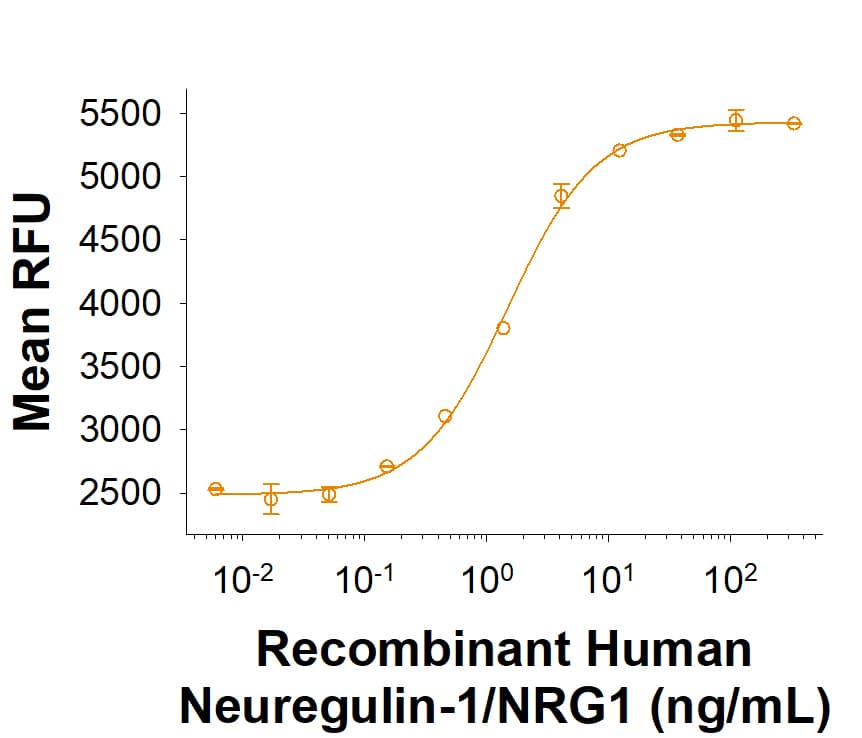Recombinant Human NRG1-beta 1/HRG1-beta 1 His Protein, CF
R&D Systems, part of Bio-Techne | Catalog # 11422-NR
His-tag

Key Product Details
Product Specifications
Source
Chinese Hamster Ovary cell line, CHO-derived human Neuregulin-1 beta 1/NRG1 beta 1 protein
Ser20-Lys246, with a C-terminal 6-His tag
Ser20-Lys246, with a C-terminal 6-His tag
Purity
>95%, by SDS-PAGE visualized with Silver Staining and quantitative densitometry by Coomassie® Blue Staining.
Endotoxin Level
<0.10 EU per 1 μg of the protein by the LAL method.
N-terminal Sequence Analysis
Ser20
Predicted Molecular Mass
26 kDa
SDS-PAGE
36-49 kDa, under reducing conditions.
Activity
Measured in a serum-free cell proliferation assay using MCF-7 human breast cancer cells. Karey, K.P. et al. (1988) Cancer Research 48:4083.
The ED50 for this effect is 0.250-2.50 ng/mL.
The ED50 for this effect is 0.250-2.50 ng/mL.
Scientific Data Images for Recombinant Human NRG1-beta 1/HRG1-beta 1 His Protein, CF
Recombinant Human NRG1-beta 1/HRG1-beta 1 His-tag Protein Bioactivity.
Recombinant Human Neuregulin-1/NRG1 His-tag Protein (Catalog # 11422-NR) induces cell proliferation of MCF-7 human breast cancer cells. The ED50 for this effect is 0.250-2.50 ng/mL.Recombinant Human NRG1-beta 1/HRG1-beta 1 His-tag Protein SDS-PAGE.
2 μg/lane of Recombinant Human NRG1-beta 1/HRG1-beta 1 His-tag Protein (Catalog # 11422-NR) was resolved with SDS-PAGE under reducing (R) and non-reducing (NR) conditions and visualized by Coomassie® Blue staining, showing bands at 36-49 kDa, under reducing conditions.Formulation, Preparation and Storage
11422-NR
| Formulation | Lyophilized from a 0.2 μm filtered solution in PBS with Trehalose. |
| Reconstitution | Reconstitute at 500 μg/mL in PBS. |
| Shipping | The product is shipped at ambient temperature. Upon receipt, store it immediately at the temperature recommended below. |
| Stability & Storage | Use a manual defrost freezer and avoid repeated freeze-thaw cycles.
|
Background: Neuregulin-1 beta 1/NRG1 beta 1
References
1. Buonanno, A., and G.D Fischbach (2001) Curr. Opin.
Neurobiol. 11:287.
2. Adlkofer, K. and C. Lai (2000) Glia 29:104.
3. Garratt, A.N. et al., (2000) BioEssays 22:987.
4. Yun Du et. al. (2012) J. Am. Chem. Soc. 134:6720.
5. Cote, G. et al. (2005). Exp. Cell Res. 311:135.
6. Pentassuglia, L. and Sawyer, D. (2009).
Experimental Cell Research. 315:627.
Alternate Names
Neuregulin1 beta 1
Gene Symbol
NRG1
UniProt
Additional Neuregulin-1 beta 1/NRG1 beta 1 Products
Product Documents for Recombinant Human NRG1-beta 1/HRG1-beta 1 His Protein, CF
Product Specific Notices for Recombinant Human NRG1-beta 1/HRG1-beta 1 His Protein, CF
For research use only
